Converging courses in the South Pacific
Published on February 20th, 2015
(February 20, 2015; Day 52) – Who knows if the second placed crew in the Barcelona World Race, Guillermo Altadill and Jose Munoz have recently used the official scheduled reports to pinpoint the position of their nearest rivals GAES Centros Auditivos? But with the two IMOCA Open 60s seeming to be on converging courses in the South Pacific, just 16 miles apart this afternoon, there seems to be a good possibility they might even look out and see each other. At least on their respective AIS identifying and positioning systems.
After 51 days and over 13,000 miles of racing the two boats are closing in on each other, Neutrogena slanting slightly North East looking likely to cross just ahead of Anna Corbella and Gerard Marín. The speed differences swing back and forth between the two Farr designs, Neutrogena often appearing to sail deeper angles and going slightly slower.
But for sure both will ultimately relish the challenge, not only in having a matched rival to benchmark with side by side, but also in the measure of confidence added by having another boat within reach when racing in the middle of one of the loneliest and most inhospitable stretches of ocean.
Their duel has nearly 2600 miles to run get to Cape Horn. In turn race leaders Cheminées Poujoulat now have less than 1600 miles and expect to be there around breakfast local time Tuesday, according to current forecasts and routing. Skippers Bernard Stamm and Jean Le Cam were getting into a new former sub tropical low system which was set to blast them towards the most notorious of Capes. Stamm confirmed today that they expect big winds and seas for their rounding and so are already working hard at routing for the optimum, safe approach.
With the chasing head to head duo some 1200 miles behind, Stamm says they are under no pressure at all to push unduly close to their limits.
“We’ll be there in around four days,” Stamm said. “Of course, we’re watching the conditions, as they are rough. Clearly Cape Horn doesn’t want to disappoint us. In particular, we are trying to see the best position to be in, as the seas can be very nasty even before we get there. We’re looking at the weather there and further ahead to rounding the cape itself, without looking all the way ahead to the tropics.
“But there is one rival we must not forget and that is the Pacific. That’s what sets our pace. If we don’t make good headway, we suffer more from the sea state. It doesn’t change much as far as our speed is concerned, as we try to sail as fast as we can. But it does change the pressure we feel. We don’t have any real pressure on us.”
As they head for this pinnacle landmark of ocean sailing, Cheminées Poujoulat has entered the maritime area which is the under the responsibility of the Maritime Rescue Coordination Center (MRCC) of Chile. They have been in contact with the boat to remind that it is entering one of the most dangerous shipping lanes (maritime route) in the world. This is the twelfth different MRCC which safeguards the boats racing on this edition of the Barcelona World Race. The Chilean Navy has responsibility for one of the largest maritime areas of the world and will watch over the boats as they round Cape Horn.
Cheminées Poujoulat may have set the 24hrs speed record for this edition of the race, so far, with 480 miles, but One Planet One Ocean have been knocking up some remarkable 24 hour runs with the vintage Owen Clarke designed ex Kingfisher, nearly 440 miles until early this morning. In sixth Aleix Gelabert and Didac Costa are just 360 miles behind the Garcia brothers on We Are Water.
Speaking at Barcelona World Race HQ today Gelabert’s wife, one of Spain’s best known sailors, Natalia Vía-Dufresne, double Olympic medallist, is following the race with a bit of jealousy.
“Sometimes I do wonder why they are doing that or how it’s possible they haven’t seen that,” Vía-Dufresne said. “But when I speak to him (well, just 3 times in all the race) or when I email him we never speak about the race. I am following the race also with a bit of worry, but the true is that they are very calm and Aleix is very quietly, he is not like a goat, he is not crazy as hell.”
Bruno Garcia said he looked forwards to racing across the Pacific with their friends and rivals in closer proximity. “Of course everybody is worried when your boat is not making the most miles. But, you know, objectively having OpOo quite near when we are crossing the Pacific together, they are good sailors and good friends, so it is good for us, a better option.”
Renault Captur have been slowed by light winds as they progress towards Wellington for their rudder repair. They are expected tomorrow and had 190 miles to go this afternoon, averaging 10-11kts.
Making good, solid speeds Spirit of Hungary’s Conrad Colman took the opportunity presented by his third trip to the top of the mast to take one of the most exciting images of the race so far!
Skippers’ quotes:
Bruno Garcia (ESP) We Are Water:
Here we have better wind conditions than yesterday when it was very variable. So now we are advancing well again.
* Worried by OpOo advance?
Of course everybody is worried when a boat is not making the most miles. But, you know, objectively having OpOo quite near when we are crossing the Pacific together, they are good sailors and good friends, so it is good for us, a better option.
* About their father.
He is quite worried if we take care or not, and we do take care. And we take care of each other, and we take care of the boat. He has taught us how to do it well. Tell him we are in the spirit of Caloni which was the boat we owned when we were children.
* Food tastes, same or different?
We have different tastes, but some things we like in common. We like Jamon, Chorizo and cheeses, but we different things and have different dishes for each of us.
* Do you think of ambitions beyond this race?
To be honest we don’t think about the future. This is a story that never ends. You start a race, finish it, and then another one begins. Life is like that. There is another step after that.
* Do you want to go solo sailing again? Which is better?
Of course, solo sailing for me is the best, it is maximum expression of sailing. Solo sailing for me is always an objective for me and for Willy. It is simply different, more intense.
Bernard Stamm (SUI) Cheminées Poujoulat:
Things have improved a bit. The seas have calmed down. We have been really slow for quite some time, with the wind going from 20-25 knots, meaning it wasn’t very easy. There were cross seas and so we couldn’t get our speed up. It’s looking better now as it is more stable.
It’s easier when there is a bit less breeze. We aren’t using the spinnaker. We’re in our usual watch system with 4-5 hours each. The watches aren’t fixed. They depend on how we’re feeling, what we’re capable of doing before collapsing (laughs).
* The fact that the rivals are all some way back
That changes a lot of things. We take more time doing manoeuvres, and are more cautious… It gives us the opportunity not to take so many risks. But there is one rival we must not forget and that is the Pacific. That’s what sets our pace. If we don’t make good headway, we suffer more from the sea state. It doesn’t change much as far as our speed is concerned, as we try to sail as fast as we can. But it does change the pressure we feel. We don’t have any real pressure on us.
* Duel Neutrogena / GAES
We’re sitting back and watching them. We’re looking at the weather in particular to see what they may be getting behind us. We’ve been in strong winds now for several days and that is set to continue. They have a less favourable wind direction, but the winds are not as strong. We’re keeping an eye on them. We may well have a good lead, but that can quickly melt away. It’s amazing to see that they are back racing side by side.
* Cape Horn
We’ll be there in around four days. Of course, we’re watching the conditions, as they are rough. Clearly Cape Horn doesn’t want to disappoint. In particular, we are trying to see the best position to be in, as the seas can be very nasty even before we get there. We’re looking at the weather there and further ahead to rounding the cape itself, without looking all the way ahead to the tropics.
We are preparing the bat as best we can so that she is ready to deal with the heavy weather. We are trying not to leave anything outside that can be swept away by the sea or the wind, to avoid having to do some risky manoeuvres in the strongest winds. For us, the best way to prepare ourselves is to keep an eye on the equipment.
Ranking at 14:00 UTC:
1. Cheminées Poujoulat (Bernard Stamm – Jean Le Cam) 8463.1 nm Distance to Finish
2. Neutrogena (Guillermo Altadill – Jose Muñoz) 1205.0 nm Distance to Lead
3. GAES Centros Auditivos (Anna Corbella – Gerard Marin) 1219.8 nm DTL
4. Renault Captur (Jörg Riechers – Sebastien Audigane) 2694.5 nm DTL
5. We Are Water (Bruno Garcia – Willy Garcia) 2860.9 nm DTL
6. One Planet One Ocean / Pharmaton (Aleix Gelabert – Didac Costa) 3220.0 nm DTL
7. Spirit of Hungary (Nandor Fa – Conrad Colman) 4133.6 nm DTL
Hugo Boss (Alex Thomson – Pepe Ribes) Abandon
Report by event media.
Background: The third edition of the Barcelona World Race is the only double-handed, non-stop, round the world race. Eight IMOCA 60 teams started December 31, 2014, with the intent to cover 23,450 nautical miles in a circumnavigation from Barcelona to Barcelona, putting the capes of Good Hope (South Africa), Leeuwin (Australia) and Horn (Chile) to port and the Antarctic to starboard. The finishes are forecasted for the end of March 2015.


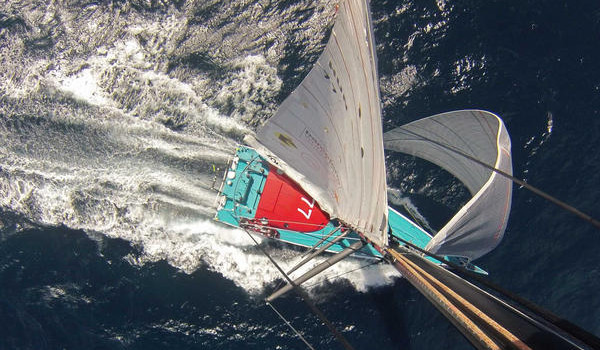

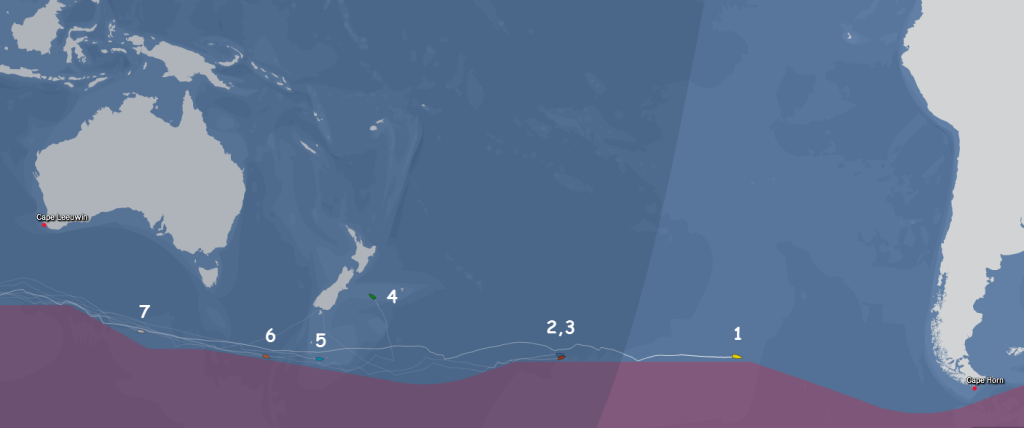

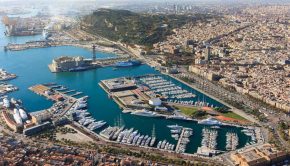
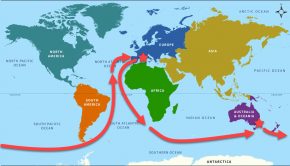
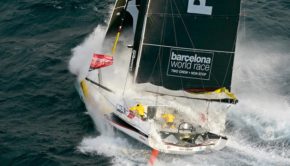
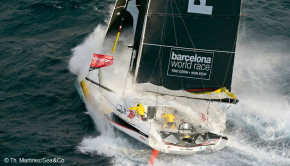
 We’ll keep your information safe.
We’ll keep your information safe.